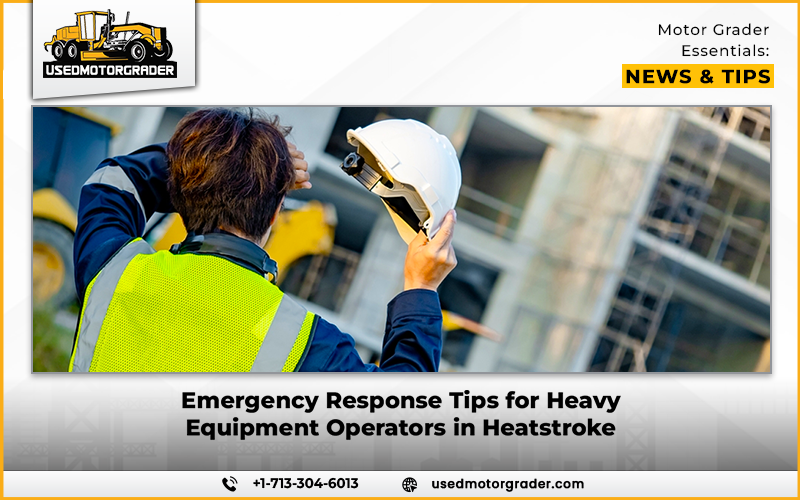Summer translates into longer workdays and sweltering heat, especially for construction and earthmoving operations. For a heavy equipment operator, working in heat can endanger both heat-related illness and equipment failure, two emergencies that demand speedy action.
Heavy equipment operators can identify early warning signs, react to emergencies, and minimize risks under hot operating conditions. Whether you operate a bulldozer, grader, or loader, the right equipment in an emergency can be a matter of life and death.
The scorching sun and the extremely harsh weather can be dangerous for both the machine and the operator. In the peak hours, the machine can overheat and possibility of potential damage.
That is why it is essential to keep oneself and the machine from issues like overheating and to keep the maintenance cooling system in the cab.
However, if anything happens to the operator or machine, the employee should know how to react promptly in the situation to manage it. Provide training and spread awareness to cope with the emergency situation that becomes inevitable in the circumstances.
Recognizing the Signs of Heatstroke in Operators
Heatstroke is a health emergency that happens when the body fails to cool down. When a heavy equipment operator is operating in direct sunlight or a poorly ventilated cab, the risk becomes high very fast, more so in cases where there is no proper hydration.
Look out to see these signs:
- Vomiting and nausea
- Hot, dry skin (no sweating in spite of heat)
- Loss of coordination
- Fainting or loss of conscience
In case a certain operator starts revealing these symptoms, work must be stopped and treatment must be started. Even mild heat stress should never be underestimated, as it may easily develop into the life-threatening heatstroke.
What to Do When In Heatstroke
An emergency response plan should be clear in any jobsite where the working conditions are under high heat.
This is what you have to do when someone gets heatstroke or finds themselves in a troublesome situation. The first step is to remove the operator or construction worker from the heat. Shift the operator to a cool or air-conditioned room immediately.
- Cooling of the body quickly
Put cold packs, wet towels, or spray water on the individual. Unbutton/unzip extra layers, open windows, and use fans or mobile air conditioners.
- Request emergency medical assistance
As the cooling measures are offered, contact emergency responders. Heatstroke can also destroy the internal organs and cannot be treated lightly on-site.
- Write and report
Document the accident and revise your site safety plan. This will help to avoid subsequent emergencies by evaluating where things went wrong and what the good things.
Managing Equipment Malfunction in High Heat
Similar to a human body or a heavy equipment operator, a heavy equipment machine may malfunction under extreme summer temperatures. When machines are overworked in the heat, overheated engines, failure of the hydraulic system, and coolant leaking are also common issues.
There are warning signs:
- Running of engine temperature gauges in the red zone
- Strange odors of the engine (burning oil, coolant)
- Smoke or steam at the hood or engine region
- Auricular collapse, or the loss of hydraulic power or pressure
In case of any of them, the machine must be reduced in fluid or efficiency checked. When the machine is hot or failing, continued operation can cause serious damage to the major components and pose safety hazards.
Emergency Steps for On-Site Equipment Failure
Park and switch off the machine safely. In case of possibility, move equipment off active work zones and shut down safely.
Wake up your expert and your maintenance crew. Report the problem and lockout out tagout processes on site where they exist.
Never use spot repairs when it is hot. Do not inspect and repair work when the machine is overheated. Furthermore, avoid Maintenance work before the equipment has cooled.
Burns or injuries due to pressure may be received when working on a hot engine or hydraulic system.
Maintenance logs enable the fleet manager to recognize patterns, particularly when there is a repeat failure in more than one unit due to high heat.
Key Takeaway
Every heavy equipment operator faces a unique set of summertime challenges related to machine performance, safety, and health that go beyond productivity.
Although heatstroke and equipment failure are serious risks, they can be avoided with careful preparation and prompt response procedures.
Knowing how to react can make the difference between a minor problem and a serious emergency during the sweltering summer months.
Safety never stops, not even in the sun, so make sure your crew is trained, your equipment is watched over, and your response plans are prepared.


